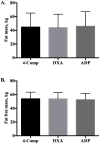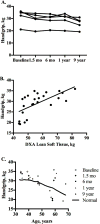Long-Term Body Composition Changes in Women Following Roux-en-Y Gastric Bypass Surgery
- PMID: 26838526
- PMCID: PMC5539958
- DOI: 10.1177/0148607115625621
Long-Term Body Composition Changes in Women Following Roux-en-Y Gastric Bypass Surgery
Abstract
Background: Although most individuals experience successful weight loss following Roux-en-Y gastric bypass (RYGB), weight regain is a concern, the composition of which is not well documented. Our aim was to evaluate changes in body composition and handgrip strength as a measure of functional status in participants from a previous 1-year post-RYGB longitudinal study who had undergone RYGB approximately 9 years prior.
Methods: Five women from an original larger cohort were monitored pre-RYGB and 1.5 months, 6 months, 1 year, and 9 years post-RYGB. Body composition was assessed at all time points using dual energy x-ray absorptiometry and multiple dilution. Handgrip strength was measured using a digital isokinetic hand dynamometer (Takei Scientific Instruments, Ltd, Tokyo, Japan).
Results: Mean time to final follow-up was 8.7 years. Lean soft tissue (LST) loss over the ~9-year period was on average 11.9 ± 5.6 kg. Compared with 1-year post-RYGB, 9-year LST was 4.4 ± 3.0 kg lower ( P = .03). Fat-free mass decreased over the 9-year period by 12.6 ± 5.8 kg. Mean fat mass (FM) decreased from 75.4 ± 22.6 kg pre-RYGB to 35.5 ± 21.5 kg 1 year post-RYGB but then trended toward an increase of 8.6 ± 7.0 kg between 1 year and 9 years post-RYGB ( P = .053). Loss of LST was correlated with loss of handgrip strength ( r = 0.64, P = .0005).
Conclusion: The continued loss of lean mass associated with decreased handgrip strength occurring with long-term trend toward FM regain post-RYGB is concerning. The loss of LST and functional strength carries particular implications for the aging bariatric population and should be investigated further.
Keywords: Roux-en-Y gastric bypass; bariatric; dual-energy x-ray absorptiometry; fat-free mass; handgrip strength; lean body mass; lean tissue; obesity.
Figures



Similar articles
-
One Year Changes in Body Composition and Musculoskeletal Health Following Metabolic/Bariatric Surgery.J Clin Endocrinol Metab. 2025 Apr 22;110(5):e1598-e1608. doi: 10.1210/clinem/dgae496. J Clin Endocrinol Metab. 2025. PMID: 39108088 Free PMC article.
-
Early reduction of resting energy expenditure and successful weight loss after Roux-en-Y gastric bypass.Surg Obes Relat Dis. 2017 Feb;13(2):204-209. doi: 10.1016/j.soard.2016.08.027. Epub 2016 Aug 18. Surg Obes Relat Dis. 2017. PMID: 27692914
-
Resting energy expenditure after Roux-en Y gastric bypass surgery.Surg Obes Relat Dis. 2018 Feb;14(2):191-199. doi: 10.1016/j.soard.2017.10.014. Epub 2017 Oct 31. Surg Obes Relat Dis. 2018. PMID: 29275093
-
Mechanisms of improved glycaemic control after Roux-en-Y gastric bypass.Dan Med J. 2015 Apr;62(4):B5057. Dan Med J. 2015. PMID: 25872541 Review.
-
Long-term effect of bariatric surgery on body composition in patients with morbid obesity: A systematic review and meta-analysis.Clin Nutr. 2021 Apr;40(4):1755-1766. doi: 10.1016/j.clnu.2020.10.001. Epub 2020 Oct 15. Clin Nutr. 2021. PMID: 33097305
Cited by
-
Sarcopenic obesity in older adults: aetiology, epidemiology and treatment strategies.Nat Rev Endocrinol. 2018 Sep;14(9):513-537. doi: 10.1038/s41574-018-0062-9. Nat Rev Endocrinol. 2018. PMID: 30065268 Free PMC article. Review.
-
Preserved Muscle Strength Despite Muscle Mass Loss After Bariatric Metabolic Surgery: a Systematic Review and Meta-analysis.Obes Surg. 2023 Nov;33(11):3422-3430. doi: 10.1007/s11695-023-06796-9. Epub 2023 Sep 20. Obes Surg. 2023. PMID: 37728838 Free PMC article.
-
Rate and Determinants of Excessive Fat-Free Mass Loss After Bariatric Surgery.Obes Surg. 2020 Aug;30(8):3119-3126. doi: 10.1007/s11695-020-04654-6. Obes Surg. 2020. PMID: 32415634 Free PMC article.
-
The Optimal Nutritional Programme for Bariatric and Metabolic Surgery.Curr Obes Rep. 2020 Sep;9(3):326-338. doi: 10.1007/s13679-020-00384-z. Curr Obes Rep. 2020. PMID: 32451780 Review.
-
Proceedings of the 2017 ASPEN Research Workshop-Gastric Bypass: Role of the Gut.JPEN J Parenter Enteral Nutr. 2018 Feb;42(2):279-295. doi: 10.1002/jpen.1121. JPEN J Parenter Enteral Nutr. 2018. PMID: 29443403 Free PMC article. Review.
References
-
- Blachar A, Federle MP, Pealer KM, Ikramuddin S, Schauer PR. Gastrointestinal Complications of Laparoscopic Roux-en-Y Gastric Bypass Surgery: Clinical and Imaging Findings. Radiology. 2002;223(3):625–632. - PubMed
-
- Elliot K. Nutritional considerations after bariatric surgery. Crit Care Nurs Q. 2003;26(2):133–138. - PubMed
-
- Pugnale N, Giusti V, Suter M, et al. Bone metabolism and risk of secondary hyperparathyroidism 12 months after gastric banding in obese pre-menopausal women. Int J Obes Relat Metab Disord. 2003;27(1):110–116. - PubMed
-
- Faintuch J, Matsuda M, Cruz M, et al. Severe protein-calorie malnutrition after bariatric procedures. Obes Surg. 2004;14(2):175–181. - PubMed
-
- Carey DG, Pliego GJ, Raymond RL. Body composition and metabolic changes following bariatric surgery: effects on fat mass, lean mass and basal metabolic rate: six months to one-year follow-up. Obes Surg. 2006;16(12):1602–1608. - PubMed
Publication types
MeSH terms
Substances
Grants and funding
LinkOut - more resources
Full Text Sources
Other Literature Sources
Research Materials

